| Interview with Martin Hudy |
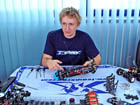
Martin Hudy
(click to enlarge) |
| The popular Australian RC Magazine Racing Lines made an interview with junior designer Martin Hudy about making the XRAY T1FK'05. With the kind permission of Racing Lines we publish the interview online. Now all XRAY fans can get some of the behind-the-scenes information about making a new car as well take a look at some early stage prototypes. XRAY now give you access to the R&D information and brings you in the action. Enjoy. |
|
|
| RL: What part did you play in the design of the T1FKâ™05? |
|
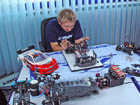
Martin working on his set-up
(click to enlarge) |
MH:
As a junior engineer my duty was to help our senior designers during the whole designing project. As with all other projects done by XRAY, the project team leader was Juraj (Mr. Juraj Hudy â“ father of Martin Hudy) who is the one who makes the final decisions and the one who leads all the R&D staff. My task was to incorporate all the racing experience we had from the T1FK, to carry over the good experiences, but mainly to improve the insufficient areas where the T1FK was lacking behind the competition. |
|
|
| Any new idea and development was turned during the week into a prototype which we then tested the whole weekend, always at a different track. After the weekend I had to recapture all the pros and cons of new parts and then use the best ones, or still to continue on improving upon those with which we were not still 100% satisfied. This was a never-ending process as you could continue improving every week, but we had a deadline to catch and we had to make everything on time. |
|
|
| RL: What were your design aims with the T1FKâ™05? |
|
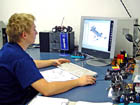
Designing T1FK'05
(click to enlarge) |
MH:
The main aim was of course to make an improvement over the previous car. The T1FK was already an extremely successful car which won plenty of major races around the world and was receiving awards for the worldâ™s best car from magazines, so we had a very difficult task to come out from under our own shadow. The main focus was to make the car more easy to drive, increase the corner speed, increase the drive train efficiency, and make the car faster. |
|
|
| RL: What would you say are the major improvements in the T1FKâ™05? |
|
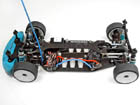
First prototype with low motor position
(click to enlarge) |
MH:
The drive train efficiency and the balance are the best improvements. We returned back to the larger pulleys on diffs and made new larger 20T middle pulleys. The drive train efficiency is incredible thanks to the large pulleys all around. We played a lot with the proper weight distribution and had dozens of different chassis layouts to find the best possible compromise. There are plenty of other innovative improvements such as the new patent XRAY Multi-Diff, rear diff height adjustment. |
|
|
| RL: What effect does the T1FKâ™05 layout have on the way the car handles compared to the T1 Factory Kit, the FK-04 weâ™ll call it? |
|
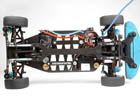
Notice battery placements
(click to enlarge) |
MH:
The FKâ™05 has more steering, improved cornering speed, and is much more stable, thus making the car easier to handle. To come to the final design we had to go through dozens of different concepts where we tested one day balance, the other day the weight transfer influence on steering, etc. We tested saddle pack configurations vs. 6-cell pack along one side⦠batteries in front vs. rear⦠different drive train concepts⦠motor placed in the middle of the car vs. on the side of the car⦠motor mount incorporated with the rear bulkhead vs. single motor holder⦠and many more things. |
|
|
| All of these different designs have completely different influence on car handling and performance, so it was very difficult task to test all of them and to find the best combination. |
|
|
| RL: In a time when manufacturers are loading their cars with all the tuning options available, why did you decide to exclude sway bars from the T1FKâ™05? |
|
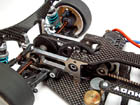
Rear bulkheads
(click to enlarge) |
MH:
The anti-roll bars were never included in any XRAY touring car kit. The handling of the T1 touring cars is a bit different from others and in many conditions the anti-roll bars are not needed at all. Therefore we let the customer decide to purchase the anti-roll bar when he needs it, instead of adding it to the kit and thus increasing the price of the kit. |
|
|
| RL: Also, why is there no battery brace in the T1FKâ™05 kit? Was that just because some other manufacturers are doing that or was there a specific reason? |
|
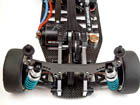
Notice the motor position
(click to enlarge) |
MH:
Most of today's modern touring cars use the tape to hold the batteries. This is done for a reason, since when using tape you will not risk a tweak to the chassis and you also save weight. We were not certain whether or not to include the battery strap because the Smart Battery holder system is an XRAY innovation and trade mark. In the end, we decided to not include something that is not absolutely necessary for racing and which can be purchased anytime by the driver if he decides he wants it. |
|
|
| We are always looking for customer feedback and when we receive feedback that the customer is willing to pay a bit more to have the battery holder included in the kit, we will certainly do it. |
|
|
| RL: Youâ™ve released some option parts. Are there any option parts that you would recommend as a âśmust haveâť for the T1FKâ™05? |
|

Martin at the Worlds
(click to enlarge) |
MH:
To answer this question properly would take a separate article! I will try shortly though. When preparing your car you have to make the set-up based on the racing conditions. You have to consider if you will run on asphalt or carpet, using either rubber or foam tires, or if the traction is low, medium or high. These factors, besides plenty of others, are the basic factors that influence the way you must set-up the car. |
|
|
| Each racing condition requires different set-up and different parts to be used. Generally we can say that when grip decreases you must soften the car and make it more flexible; and vice versa when the grip increases you must stiffen the car and decrease or remove the flexibility completely. When racing on foam tires the traction is usually super high, therefore we offer the optional thick chassis and wider top deck which will make the car very stiff. Then of course hard suspension parts must be used as well. |
|
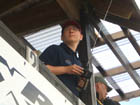
(click to enlarge) |
| The car out of the box is very good for medium grip conditions and does not require any extra options. For low grip conditions you have to make the car more flexible by removing the front alu top deck mounts and removing some screws from the bulkheads from bottom of the chassis. We now run a production 2.0mm chassis which we tested in very low grip conditions and the car was simply excellent. Because of the different parts required for different set-up, I cannot give any general advise which options a customer should buy. |
|
|
| Everybody should only get options which are neccessary for the conditions where they run the car. Typically option parts which are a must have in US are not neccessary in Europe, and vice versa. |
|
|
| RL: The T1FKâ™05 is remarkably light. Did you plan to make it so light or did it just turn out that way? |
|

Other prototype - batteries already at one side
(click to enlarge) |
MH:
Of course one of the main aims when designing parts is to make each part as light as possible but at the same time appropriately durable and always strong enough to withstand the abuse of racing and have a long life. Using very special materials we can manufacture the lightest parts without compromising the strength. XRAY has been known for manufacturing the lightest parts in the industry and this is why the drive train efficiency on T1 cars has been always one of the best. |
|
|
| Making the car as light as possible out of the box will be a great tuning aid for the driver to balance the car with additional weight as necessary. Additional weights, which are installed on the car achieve a weight limit, are usually placed on the chassis to keep the low CG. Experimenting with additional weights and weight distribution has lately become very important part of the set-up procedure the top drivers have been using. |
|
|
| RL: When we first ran the T1FKâ™05 on foam tires, we needed approximately 100grams of ballast to make the weight limit. Most people will have that problem so where do you suggest is the best spot to place that ballast on the T1FKâ™05? |
|

(click to enlarge) |
MH:
Always put the weight on the chassis. As the T1FKâ™05 has a great balance out of the box we usually put the flat weights in the center line under the long belt and in the rear under the short belt. If this is still not enough, put the weight next to the top deck mounts. On the T1FKâ™05 we do not put weights anymore behind the front bumper as the car itself has a lot of steering and adding the weight will cause the car to oversteer. |
|
|
| RL: The Multi-Diff™ is such a logical extension of the one-way. Whose idea was that? How did it come about? I suppose I should ask also, why did it take so long for someone to think of it? |
|
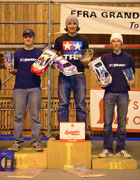
Martin on podium at the recent EFRA GP
(click to enlarge) |
MH:
The XRAY Multi-Diff™ is something we are very proud of. It is one of the latest XRAY innovations and patents. Even though it looks very simple and easy, to develop such an idea required the proper engineering knowledge and necessary creative imagination. Usually big innovations are small and easy things. Others may work around them and will never think about it. The idea of the Multi-Diff™ was brought by Juraj Hudy and it came from a simple aim to make one diff that will work for as many conditions as possible. Juraj is very busy and he has no time to work on the car, that is why he always designs the car to be not only fully adjustable but first of all easily adjustable without exchanging parts wherever possible. |
|
|
| RL: How does the Multi-Diff™ in solid one-way mode affect the car compared to the one-way diff mode? |
|
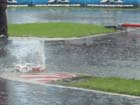
A bad luck at the Euros'04 after wash down
(click to enlarge) |
MH:
The solid one-way is excellent in low-grip conditions. It makes the car more stable and easy to drive and creates a feeling of having more overall grip. It makes the car push a bit out of the corner, so it will require a bit of practice to get used to the different feeling. When the grip increases, I just simply remove the internal locking axle to make it a standard one-way. When there is very low grip I reinsert the internal locking axle and then fully lock the one-way to make it a solid axle. This makes the car easier to drive in low grip conditions. |
|
|
| RL: What effect does changing the diff angle and height have on the carâ™s handling? |
|
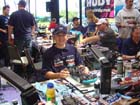
At the Snowbirds'05
(click to enlarge) |
MH:
The diff height adjustment is also one of the XRAYâ™s innovations and a patent we brought and introduced. I am sure this very small but innovative tuning feature will in a short future be used in all other touring cars as well. We are of course proud to be the innovator and this is why we put so much emphasis and effort on the R&D. |
|
|
| Setting the diff in the low position makes the car easier to drive because the car is very stable. Setting the diff in the upper position will decrease the grip in rear which will make the car more aggressive and create more steering. Having the diff in the upper positions makes the car a bit more difficult to handle and requires higher racing skills. The middle diff position is a mixture of both above mentioned characteristics. On our prototypes we had the same diff height setting feature on front bulkheads as well, but we never found the upper position to necessary; therefore we did not incorporate the diff height adjustment feature in the front. Featuring the front diff height adjustment might be a good marketing item but at the end it could create set-up problems for regular a driver; which is something we primarily care about, so we decided not to make it for front. |
|
|
| RL: Itâ™s more common to have wheel nuts to secure touring car wheels, what is the advantage in using screws (used in all XRAY cars)? |
|

Another version of prototype
(click to enlarge) |
MH:
We have been using the hex wheel axles from the very beginning because we like them and we believe they are at least as efficient as any other systems used in other cars, if not more. And I believe we have proved this over time. The public was not used to this different system, because almost all touring cars have been using the conventional axles with hex nuts. |
|
|
| As with all other new and unconventional things, people were doubtful about this system and it took us some time to convince the public that there is nothing wrong about the XRAY wheel axles, both design- and performance-wise. Using the larger steering blocks and larger uprights enables us to use larger ball-bearings with more and larger balls inside. Using larger ball-bearings, the drive train efficiency is very effective and the life of the bearings higher. |
|
|
| RL: The T1FKâ™05 appears to be primarily designed to run well on rubber tires. We know from race results here it also works very well on foam. What changes from the factory setup would you consider to make the T1FKâ™05 even better on foam tires? |
|

Notice the chassis layout
(click to enlarge) |
MH:
For the foam tires we suggest setting up the car to be stiff. I suggest doing following: install the wide top deck and connect it to the chassis in the front and rear with alu top deck mounts. For this you will need to purchase an extra set of alu top deck mounts. The suspension should be stiff as well; therefore I strongly suggest using hard arms and hard C-hub blocks. |
|
|
| The stock springs will be way too soft for foam tires, so you will need to install stiffer springs (the exact stiffness of which solely depends on the very particular track condition). As far I know in Australia you run on larger tracks so I am sure you will take the benefit from the standard one-way setting. Running on smaller diameter foam tires we use the optional front foam shock tower #302095 but this item is not a "must have" and stock front shock tower will do a good job. If using the foam tires on carpet, which I think is not a typical Australian track; you may also benefit from the thick 3.0mm chassis. For foam tires we usually you a differential in the front. |
|
|
| RL: Does XRAY have a preference for rubber tires over foam tires? |
|
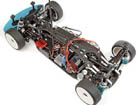
Motor placed to the center of chassis
(click to enlarge) |
MH:
To design a car for foam tires is very easy because running on foams you usually have high grip. If there would be only foam tire racing, it would make the life so much easier. But reality is different, and we have to keep in mind during the designing stage that the car will also be run on rubber tires indoors and outdoors and this is where the challenge and the difficult part is. I personally believe that European and Japanese teams racing almost exclusively on rubber tires gives them a huge competition advantage when designing new cars and new parts. |
|
|
| Our own experience is that when you design a car that works great on rubber tires, it will almost surely work great on foam tires as well (of course with appropriate set-up and small different parts as mentioned). Also, since European and Japanese teams are racing on rubber tires which are very sensitive to the grip and set-up, they gain much more experience how to set-up the car properly and have knowledge how small things influence the car. I believe we will see a strong push from European and Japanese manufacturers. |
|
|
| RL: Jilles winning Snowbirds must have been a big thrill for him and also for you and XRAY? |
|
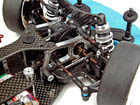
Testing of the front diff height adjustment
(click to enlarge) |
MH:
The Snowbirds was definitely not only one of the most competitive races, but first of all one of the most important races for us. It was the first race when the whole team was officially using the T1FKâ™05 so a lot of attention and pressure was put on our team. We had tested the car for several months before the race and the whole team was very confident in the car which gave us the necessary equability and we could focus on the small things. Leaving for the race we still had to finish some new parts which were finished only a few minutes before we left. |
|
|
| Thankfully we have all the manufacturing technologies in-house so nothing can match the flexibility when it comes to new parts production. However, fairly I have to mention that the success at the Snowbirds has to be addressed to the whole team. Without the great cooperation of all team members we would not be able to succeed for sure. As this is a non-stop race and practice is also at night, we had a schedule who was testing when and what. Juraj handmade some small parts in the pits, which some drivers tested during the night and in the morning we had a result and the whole team adjusted the set-up and changed the parts. With this teamwork we tuned the car in the practice and had the best car for the qualifications and finals. The XRAY team was unbeatable and the new T1FKâ™05 dominated the whole race. Jilles won both categories and we had 4 cars in the A main with me finishing in 9th position, so there was a great result for myself as well. However this was just the beginning of the season, so there will be still plenty of races ahead of us in which to prove the T1FKâ™05 is the best of the best. A few weeks ago the US team (lead by Ralph Burch and Mike Dumas) confirmed the great performance of the car at the US Nationals by taking the double win. We have great expectations for this season which is going to be interesting because other teams do not rest and work also very hard. I think this hobby has reached the level of F1 professionalism and only those who work hard and are prepared and those who constantly develop can keep up. I am sure XRAY will stay as usual in the lead. |
|
|
| RL: I guess you are looking forward to the LRP Masters? Youâ™ve got a strong team entered and the competition is going to be intense. Youâ™re confident the T1FKâ™05 will go well on carpet with rubber tires? |
|
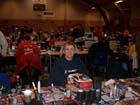
In the pits
(click to enlarge) |
| MH: As I am answering your interview just after we have returned back from LRP, I can already tell how the team and the T1FKâ™05 were doing at this race. The 2005 LRP Masters was definitely the most competitive rubber indoor race ever. The list of drivers featured all the World Champions: Marc Rheinard (â�04), Surikarn (â�02), Hara ('00), Spashett (â™98). We had the European Champions Levanen, Ahoniemi, Kaerup and plenty of other top drivers such as Masami Hirosaka, Adachi, Brian Kinwald, Matt Francis, and the list could go on. |
|
|
| Simply the best 130 drivers from all around the world entered this non-official Carpet World Championship. XRAY has put a strong team together as well. We had both US Champions Mike Dumas and Ralph Burch supporting the European team which consisted of Jilles Groskamp, the Myrberg brothers, Alex Hagberg, Viktor Wilck, Alex Stocker, Steffen Leinburger, Michal Bok, and Martin and Juraj Hudy. Coming to LRP race we had great expectations but also a kind of fear because in the last few years we always had a bad luck in the LRP race. Sometimes you do not need only the best car and driver but also a bit of luck and in the last few years the luck was never with us at the LRP race. Coming to the 2005 LRP we had tested a lot on LRP tires. As usual, Juraj made some small new parts which we hand out at the race so we had to spend a bit more time on set-up adjustment. In the qualifiers we were always very close but not enough for A final placement. Jilles was very fast from the beginning and at the end was able to qualify 6th in the A final. We had Joel Myrberg, Mike Dumas, Alex Hagberg and Alex Stocker qualify in B main, and myself along with Viktor Wilck and Steffen Leinburger qualified for the C final. Juraj helped Jilles with his set-up for the final and Jilles was incredibly fast. In the second final he managed to finish 3rd and in the last final he drive through the crowd and in an exciting and very close battle with Masami he passed him and finished second behind Marc Rheinard. The overall points put Jilles on the podium and secured him overall 3rd position which is a great result for XRAY. At the end we had 5 XRAY cars in the top 20, the most from all manufacturers, which is a nice result. |
|
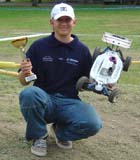
1/8 Off-Road racing
(click to enlarge) |
| We have been looking forward to the rest of this year and as usual we will keep developing new ideas and new products. Enjoy the racing and have fun. |
|
|
Age: 21
Occupation: R&D, professional RC racer, student
Qualifications/Course being studied: Engineering Degree, currently studying English language at a US University
Years racing R/C cars professionally: 4 years
Other R/C interests: RC cars only
Favorite R/C car class: 1:10 electric TC, 1:8 off-road
First R/C car: Serpent Vector
Achievements in R/C car racing: National Champion in Eastern Europe, US Snowbirds finalist
Favorite R/C race meeting: US Snowbirds Nationals
Favorite R/C track: too many to list, but our own future track will definitely be one of the best
Other hobbies/sports: squash, floorbal
Favorite relaxation: RC car racing
Favorite food: Italian, Slovak food â“ no hamburgers
Favorite holiday destination: Greek Islands
What full size car do you drive: a very old Mazda 323
What do you plan to be doing in five years time: senior R/C car engineer and (hopefully still) professional RC driver
All time best driver you have seen: Masami Hirosaka for his personality and professionalism, Atshushi Hara for his racing skills, and Jilles Groskamp for being my team buddy
Will you be racing EP Off-Road Worlds? This year, in addition to the ETC, I plan to focus on nitro off-road racing and to compete with the XRAY XB8⦠this will make for a very full schedule. |
|























